Expo Line picks up speed
March 24, 2011
As the first “road tests” begin on the initial phase of the new Exposition light rail project, a series of recent decisions is blazing the trail toward the line’s ultimate finish in Santa Monica.
A partial opening of the Expo Line from downtown Los Angeles to La Cienega is planned for this fall, with the conclusion of Phase 1 to Culver City expected next year. Meanwhile, work is beginning in earnest on Expo Phase 2, which will extend the line to Colorado and 4th Street in Santa Monica by 2015. (This interactive map shows the entire 15.2 mile route.)
Expo’s Board of Directors on March 18 voted to award the Phase 2 design-build contract to the firm Skanska/Rados. The board also voted to build an aerial crossing and station at Sepulveda instead of a street-level crossing, which was opposed by some neighborhood groups.
“Sepulveda is the major north-south thoroughfare on the Westside. Putting an at-grade crossing there is almost like putting an at-grade crossing on the 405 Freeway,” said Chuck Ray, co-chair of the Mar Vista Community Council’s Transportation and Infrastructure Committee, which backed the aerial option.
The elevated crossing and station will cost nearly $5.3 million more than the street level version. But the city of Los Angeles is picking up the tab for the additional cost, using money from the West L.A. traffic mitigation fund. (The motion by Councilmembers Paul Koretz and Bill Rosendahl is here.) The Phase 2 overall budget is $1.5 billion.
“This is an enhancement to the project. It will be a benefit to the project, to the city and to the Westside,” said Samantha Bricker, Chief Operating Officer for the Expo Line Construction Authority.
The Expo Board also voted in favor of the “no-parking” option at the Expo Line’s Westwood station. This option was preferred by some in the community, who feared that a proposed 170-space parking lot would draw too much additional traffic to their neighborhood.
“Putting a parking lot in the middle of our residential neighborhood is asking too much,” said Sarah Hays, co-chair of the group Light Rail for Cheviot.
Expo officials will be soliciting more public input for the Phase 2 design-build process at a series of community meetings in early May. (The dates will be announced soon.)
Meanwhile, the line’s Phase 1 progress was visible around USC earlier this week when a mock-up of a future Expo Line train (actually a flatbed pushed by something called a speed swing) took a ride on the tracks to make sure everything lines up properly with the station platforms.
Posted 3/24/11
County rescuers back in town—for now
March 24, 2011
You could call them the masters of disaster.
But even with an internationally-acclaimed skill set and more frequent flier miles than you can shake a boarding pass at, Los Angeles County’s urban search and rescue team has never before had a run—or a wake-up call—quite like this one.
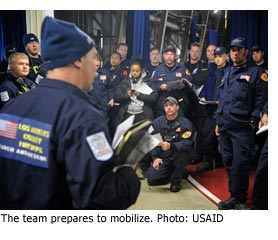 No sooner had they returned from their post-earthquake work in Christchurch, New Zealand than they were summoned to Japan less than 36 hours later to help with the aftermath of the deadly quake and tsunami there.
No sooner had they returned from their post-earthquake work in Christchurch, New Zealand than they were summoned to Japan less than 36 hours later to help with the aftermath of the deadly quake and tsunami there.
“That is a first for us as a team,” said Battalion Chief Tom Ewald, who between disaster assignments heads up the county Fire Department’s Battalion 3, serving East Los Angeles and nearby communities.
The back-to-back deployments made for some joking around on the tarmac as the team—formally known as California Task Force 2—came back from mission No. 2.
“Let’s make it more than 36 hours this time before seeing each other again,” they told each other before heading home at last.
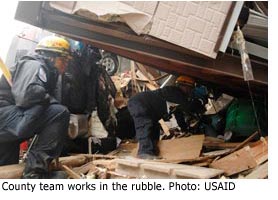 But the lessons learned on both missions are no laughing matter. And they hit close to home for members of the team because both New Zealand and Japan are affluent, highly-developed countries with many similarities to Southern California.
But the lessons learned on both missions are no laughing matter. And they hit close to home for members of the team because both New Zealand and Japan are affluent, highly-developed countries with many similarities to Southern California.
“We write off a lot of the lessons learned in underdeveloped countries,” such as Haiti, Ewald said, because of stark differences in building codes and other factors.
This time, “some of the takeaway was how these types of disasters would have impacted Los Angeles County.”
“Christchurch looks just like downtown Pasadena, or Long Beach,” he said. And as for the tsunami that devastated Japan: “Their only crime there was having exposure to a coastline, which we also have…How would we respond if that kind of widespread, catastrophic event had happened here?
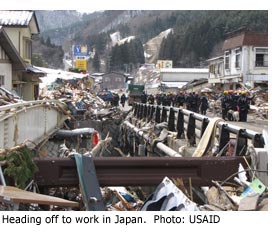 “The skills we learned there are directly transferable.”
“The skills we learned there are directly transferable.”
Ewald said both incidents point up the need to further hone disaster planning and preparedness in Los Angeles, and suggest that a “decentralized decision-making” process may be required in the event of a massive catastrophe like that experienced in Japan.
On a personal level, Ewald—who managed to grab the time to watch “American Idol” with his family between deployments—took advantage of some rare down time early in the week to drop out of sight, as far as work was concerned.
“I kind of kept myself below the radar,” he said. “My cup runneth over.”
California Task Force 2 returned home from Japan on Saturday, March 19. This YouTube video captures the homecoming, as does this CBS Channel 2 video. An array of still images showing the team’s work in Japan and New Zealand is on Facebook. And a National Public Radio report is here.
Posted 3/23/11
Judge rejects Expo Line challenge
February 24, 2011
In a significant victory for the Expo Line light rail project, a Superior Court judge has turned away a legal challenge that could have delayed or permanently derailed the line’s final leg to Santa Monica.
Judge Thomas I. McKnew, Jr., ruling in a case brought by the group Neighbors for Smart Rail, found that the environmental impact review for the Expo Line’s second phase was sound.
“EXPO carefully made its decision concerning the project with its environmental consequences in mind,” McKnew said in his ruling, which was faxed to attorneys in the case Tuesday.
There is no evidence, the judge found, to support the neighborhood group’s claim that Expo manipulated the alternatives “so that the project would appear to be better from a cost and environmental standpoint than the other choices.”
Supervisor Zev Yaroslavsky, a strong supporter of the project and a member of the Expo construction authority’s board of directors, which approved Phase 2 of the project last year, called the decision “a major milestone on the road to finishing the second phase of the Expo light rail project from Culver City to Santa Monica.”
“The court’s ruling is thoughtful and thorough and validates the difficult and meticulous work that the Expo Light Rail Authority, its staff and consultants did to ensure that this project will be safe, environmentally sound and sensitive to the communities through which it will travel,” Yaroslavsky said.
When completed, the 15.2 mile line will provide access to many cultural and community venues in downtown and beyond, including USC and the beach. It is expected to carry 64,000 passengers a day, making it one of the most heavily used rail lines in the country, Expo officials said.
Proponents of the Expo Line, which is being financed largely with revenues from the voter-approved Measure R, note also that it will be a key conduit for workers commuting to the jobs-rich Westside.
Opponents in the Neighbors for Smart Rail group, which includes a number of local homeowners associations, say they are not against a rail system as such, but contend it should run underground for safety and quality of life reasons.
But the judge found that Expo officials had fully explored the alternatives to running at street level and were correct in rejecting those approaches. Going underground could have caused “disruption of gravity fed storm drains, potential flooding of underground stations, increased construction impacts…and finally considerable increase in costs ($224.3 million.)”
The judge added that an aerial structure design “would result in creating a large physical barrier bisecting the neighborhood, create construction impacts similar to the trench option and increase costs ($65.9 million) without significant reduction of other impacts.”
The project approach that was ultimately selected is better than the alternatives from environmental, efficiency and cost standpoints, the judge found.
“We will finally have an alternative to the awful traffic, and hopefully no more delays,” said Darrell Clarke, co-chair of Friends 4 Expo Transit, which supports the Phase 2 plan. “I’ve only been an advocate for this thing for 21 years.”
However, Neighbors for Smart Rail announced it would appeal the ruling and is “confident that the appellate court will review the plain facts of the case and find that the Expo environmental review was fatally flawed and must be corrected.”
The organization said in a statement that it “remains dedicated to making sure that key north/south streets such as Overland and Sepulveda are not blocked 24 times per hour, that West L.A. traffic is not edged closer to gridlock by an ill-conceived light rail plan, that children are not put at risk by trains running just feet from their schools and that first responders will not be hampered by blocked arterials in their efforts to save lives and property.”
The $930 million first phase of the project, running parallel to the heavily congested 10 Freeway from downtown to Culver City, is scheduled to be completed in early 2012. (An opening of some of the line will take place later this year.) The $1.5 billion second phase, to extend the line to Colorado and 4th Street in Santa Monica by 2015, is expected to begin some construction later this year, after a contract is awarded to build it in coming weeks.
Posted 2/23/11
Vet squad learning new tricks
February 9, 2011
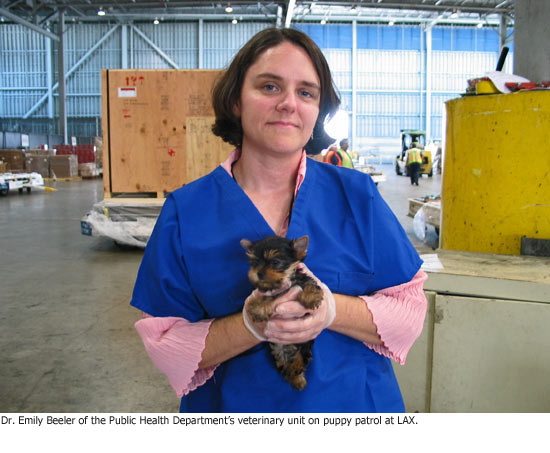 If it’s a jungle out there, Dr. Karen Ehnert and her staff are L.A. County’s safari guides.
If it’s a jungle out there, Dr. Karen Ehnert and her staff are L.A. County’s safari guides.
They know where the dogs are biting, where the rabid bats are hanging and where the raccoons have distemper.
They can tell when unscrupulous dog importers are bringing in underage puppies with bogus paperwork claiming vaccinations that never happened.
And, increasingly, they can see how the well-being of humans and animals is interrelated—for better or worse.
The multifaceted mission of the Department of Public Health’s little-known veterinary unit is testament to how times have changed for animals and humans alike in Los Angeles.
“Now that animals are becoming members of the family, sleeping in people’s beds, we need to create ways to help people improve their pets’ health, and improve their own health, too,” says Ehnert, 50, a UC Davis-trained veterinarian who’s been acting director of the unit since June. “There’s an incredible human-animal bond.” Walking and exercising family pets outdoors can also play a broader social role in the county, helping people “take back their communities,” she says. “There’s a huge public health benefit.”
The vet squad dates from a time when hoof-and-mouth outbreaks were bigger news than Hollywood gossip, and people thought of anthrax as a cattle disease, not a terrorist weapon.
A history of the department, written by Dr. Patrick Ryan, who retired last year, is full of fascinating and sometimes gruesome tidbits chronicling L.A.’s bygone livestock quarantines, tuberculosis-tainted dairy herds, disease-ridden slaughterhouses, garbage-swilling hogs and, during the Depression, roving rabid dogs attacking horses and cattle.
Well, L.A.’s no cow town anymore. And Ehnert and her unit are evolving to serve a metropolis in which people outnumber livestock, and canine rabies has long been wiped out, thanks to widespread vaccination programs. The last time a Los Angeles dog was reported to have had rabies was in 1962.
A primary mission of the team these days is still rabies control, but the culprits now are very different, with bats the likeliest to be infected, followed by skunks and foxes. This “Rabies Tales” comic, created by one of the department’s veterinarians, Dr. Emily Beeler, gives a good overview of how to handle exposure to a potentially rabid bat. (It also provides the welcome news that rabies shots are not given in the abdomen anymore.)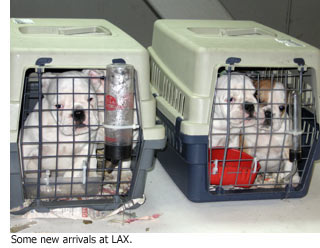
The unit takes reports on virtually every animal bite that comes to the attention of medical or law enforcement authorities in the county. It currently is working on a community-by-community analysis of where dog bites are most prevalent.
And it has an educational role, communicating with veterinarians in practice throughout the county and with the public at large about disease outbreaks and protective measures, including the importance of regular vaccinations to prevent many pet illnesses.
Lately, it’s been using the department’s Twitter feed to spread the word about how healthy human habits can lead to healthier pets. One recent Tweet focused on how smoking hurts pets.
It’s also preparing an online “Pet Health and Safety Quiz,” modeled on the department’s Food Safety Quiz (in which home cooks can test their food preparation savvy against the department’s standards for restaurant inspection and grading.)
What’s more, the vet squad has been a key player in a multi-jurisdictional effort called the “Border Puppy Task Force,” aimed at stopping the importation of sick and unvaccinated puppies through Los Angeles International Airport.
Ehnert said her team’s spot checks at the airport as part of that effort found that 40% of the large shipments of puppies coming through had falsified paperwork. The phony documents would claim, for instance, that the incoming dogs were four months old and had been vaccinated when in fact they were less than 8 weeks old—too young to have teeth, let alone effective vaccinations. In recent years, popular imported breeds coming through LAX have included English and French bulldog puppies from Colombia.
The vet squad currently is working on a proposal to turn its spot checks into a more regular monitoring arrangement, working in tandem with federal officials stationed at the airport.
The unit has undergone its share of changes over the years. Its lab was closed due to budget cuts in the mid-1990s. Its veterinary staff was shifted for a time to the Department of Animal Care & Control but later rejoined public health. Now budget cuts may once again affect the unit, which has 4 licensed vets and a registered veterinary technician among its 19 budgeted positions. Ehnert says seven of those slots are currently vacant due to retirements and leaves of absence.
The budget uncertainty hasn’t stopped the vet squad from looking ahead.
Ehnert is proposing a “2020 Healthy Pets, Healthy Families” initiative that would bring together veterinary educators, local vets, animal control agencies and public health officials with the goal of producing new standards for pet health by the year 2020. “Healthy pets can lead to healthy people,” Ehnert says in her proposal for the effort, intended as a pet-centric offshoot of the federal government’s Healthy People 2020 initiative.
“The idea is to create a model for the nation,” Ehnert says. “Nobody’s really talking about animal health and galvanizing the community.”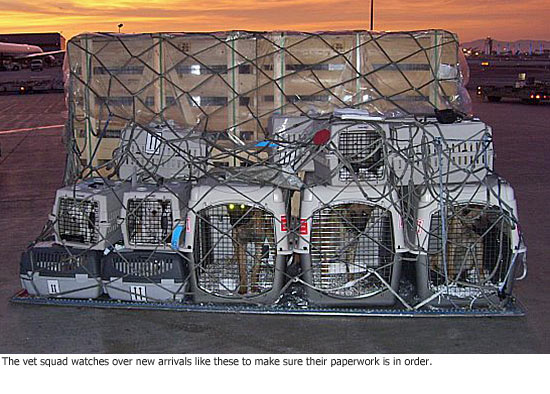
Posted 2/8/11
The next chapter for DCFS
December 13, 2010
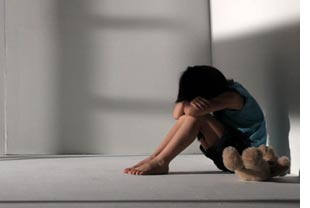 With Monday’s announcement that Trish Ploehn is departing as director of the Department of Children and Family Services, the county now has a unique opportunity—and heavy responsibility—to bring in an executive team skilled enough to remake an agency in crisis.
With Monday’s announcement that Trish Ploehn is departing as director of the Department of Children and Family Services, the county now has a unique opportunity—and heavy responsibility—to bring in an executive team skilled enough to remake an agency in crisis.
Los Angeles County has no greater duty than to protect children from neglect and abuse. But tragically, we’ve too often seen the fatal consequences of the human and institutional failures of the agency entrusted with this responsibility, the Department of Children and Family Services.
To be sure, there also is no duty laden with more landmines because of the sheer numbers of children in the system—more than 30,000. There is little margin for error. One missed sign of danger, one missed home visit, one failure to fully investigate the facts of a neighbor’s tip, can bring to an end a life that has barely begun. And one preventable death is one too many.
With the stakes so high, and the inherent difficulties so great, it’s imperative that the new director be a visionary leader and strong manager. He or she must be committed to operating with transparency and accountability. Openness, within the confines of privacy laws, helps inform policymakers and the public about what works and what’s wrong in the way we protect the children in our care.
The agency’s new director also must be guided by facts, not political orthodoxy or financial incentives that are favorable to the department but that may be jeopardizing children.
Currently, the county participates in a federal program that provides financial incentives for DCFS to shrink its foster-care rolls and leave more at-risk kids at home, while providing their families with various voluntary services. The sentiments behind the program are laudable: family preservation, maintenance and support. But given the circumstances surrounding numerous child deaths, the time has come for a new director to determine whether the department has grown too dependent on a funding scheme that exposes children to peril in irreparably broken families.
These are the facts: during the past three years, almost all L.A. County children who died because of abuse and neglect did so at home, not in foster care. I’m not suggesting that we return to the days when we removed a child first and asked questions later. I am saying that our new director must investigate why this pattern of deaths exists. Are there common threads among these cases that have yet to be explored to see how we can make our current strategy safer?
Our new director must also be willing to tackle what surely will not be an easy sell within an entrenched DCFS bureaucracy that has seen no less than half a dozen directors in its 25-year history.
One of the department’s most crucial operations is its emergency response team. In it, are the people who assess the validity of complaints that flow non-stop into DCFS about the alleged mistreatment of children. A good decision on the front lines can protect a child from harm; a bad one puts the youngster in harm’s way. Yet the emergency response team is a first stop for new DCFS employees, whose lack of experience and training would seem to make them least qualified for this responsibility.
It is crucial that this situation be fixed. Experienced workers should be reassigned to areas where their skills are urgently needed. At a minimum, they could serve as on-the-job mentors for emergency response team staffers, some of whom openly acknowledge that they feel overwhelmed by and unprepared for the decisions and consequences they confront every day.
In the days and weeks ahead, we will embark on a broad and thorough search for a new DCFS director. I’m confident that this individual will not only have the right set of qualifications and experience for the job but a passion for the mission—a passion shared by thousands of DCFS workers anxious to help shape a new era.
Getting the lead out for healthy kids
October 29, 2010
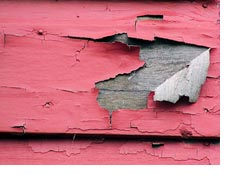 If you haven’t checked your home for sources of lead exposure, this would be a good week to start. The county Department of Public Health, in observance of National Lead Poisoning Prevention Week, is putting out the word about common sources of lead that can cause health problems, especially for children. The main cause of lead poisoning in Los Angeles County children is exposure to peeling lead-based paint, which is commonly found in houses, apartments, and buildings built before 1978. Other sources of lead exposure include contaminated ground soil, lead dust from work clothes, folk remedies like Azarcón and Greta, and imported toys and candy.
If you haven’t checked your home for sources of lead exposure, this would be a good week to start. The county Department of Public Health, in observance of National Lead Poisoning Prevention Week, is putting out the word about common sources of lead that can cause health problems, especially for children. The main cause of lead poisoning in Los Angeles County children is exposure to peeling lead-based paint, which is commonly found in houses, apartments, and buildings built before 1978. Other sources of lead exposure include contaminated ground soil, lead dust from work clothes, folk remedies like Azarcón and Greta, and imported toys and candy.
“In 2009, 671 children in Los Angeles County had seriously elevated blood-lead levels, which is entirely preventable,” said Jonathan E. Fielding, the county’s director of public health. “Lead can seriously affect a child’s brain and nervous system and may cause learning and behavioral problems.” A blood lead test is the only way to identify and confirm elevated lead levels in children.
Parents who are concerned about their children’s exposure to lead are urged to ask their child’s doctor about lead testing. Free materials in many languages, as well as answers to questions on lead poisoning prevention, are available by calling 1-800-LA-4-LEAD or online here. Parents who do not have a doctor for their child can also call the hotline for referrals to free and low-cost health services for children and teens.
Posted 10/29/10
How Westside subway got back on track
October 28, 2010
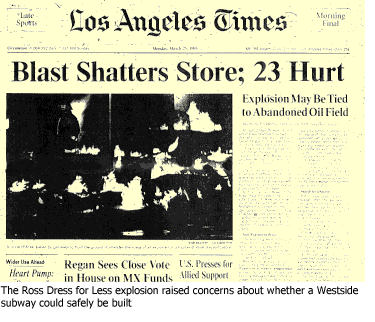 Twenty-five years ago, a methane gas explosion ripped through a Ross Dress for Less store in the Fairfax District, injuring nearly two dozen people and delivering a seemingly fatal blow to plans to build a subway along Wilshire Boulevard to the Westside of Los Angeles.
Twenty-five years ago, a methane gas explosion ripped through a Ross Dress for Less store in the Fairfax District, injuring nearly two dozen people and delivering a seemingly fatal blow to plans to build a subway along Wilshire Boulevard to the Westside of Los Angeles.
The area was designated a “methane gas hazard zone” and Congress moved swiftly to outlaw tunneling through the area.
Today, however, the subway is back. The Metropolitan Transportation Authority board on Thursday approved a locally preferred route for the Westside Subway Extension that would send the project through the once-banned territory. The board’s approval now moves the project into the final environmental review process.
“This is an historic day,” said Supervisor Zev Yaroslavsky, a member of Metro’s Board of Directors. “This is the first time in my lifetime, and in probably all of our lifetimes, that we have gotten this close, this far along the road to extending and building a public mass transportation line through the Wilshire Corridor.
“For all of the vicissitudes that we’ve had over the past quarter century,” Yaroslavsky said, “we finally are at the point where this is becoming more of a reality than a dream.”
The subway’s resurgence—one of the more remarkable comebacks in American transit history—came about in part because of more than two decades’ worth of technological advances, along with the findings of an expert peer review panel which led Congress to lift its prohibition at the urging of Rep. Henry A. Waxman.
“People had all but left it for dead,” said Raffi Hamparian, Metro’s government relations manager. He pointed to the evolution of new tunneling technology and the vote of confidence by the American Public Transportation Association’s peer review panel as two of the key turning points in the subway saga.
In a November 2005 report, the panel of nationally-acclaimed experts said it had unanimously determined that building the Westside subway, with proper procedures and technologies, poses a risk “no greater than other subway systems in the United States.”
As improbable as it might have seemed at the time, that March 24, 1985 blast, which sent flames shooting through fissures in sidewalks with its force, ended up becoming something of a galvanizing event in construction safety.
“We now have the benefit of hindsight. We also have the benefit of new technology,” said Dennis Mori, Metro’s executive officer of construction project management. He said lessons learned during the construction of Metro’s Red Line subway and Gold Line Eastside Extension will provide valuable guidance for tunneling through the gassy territory of the Wilshire corridor.
One of the biggest game-changers—literally—may be the “Closed Face Earth Pressure Balance” tunnel boring machine.
“The machine, fully assembled, is about the length of a football field,” Mori said. First used in L.A. during the Gold Line extension project that started in 2004, the machines offer operators greater control over how fast ground is displaced as they dig, lessening the risk of settlement and sinkholes.
The machines also can be outfitted with what Mori describes as “very robust ventilation equipment” to help workers avoid gas exposure while tunneling through the sometimes-challenging terrain that the Westside subway would need to traverse.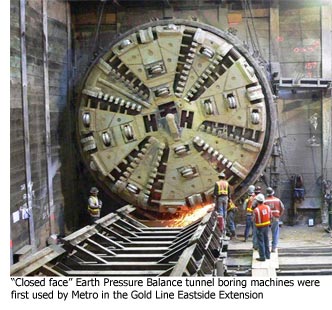
Dr. Geoffrey Martin, a USC professor emeritus and member of Metro’s tunnel advisory committee, said that advances in “slurry shield” tunneling technology also have made it safer for workers to remove gassy soil.
On Thursday, the board adopted a preferred route that would extend the Purple Line subway along Wilshire from Western Avenue to the V.A. Hospital. The route’s cost, about $4.2 billion in 2009 dollars, could rise to more than $5 billion by the project’s completion. All of the potential routes considered as part of the subway’s draft environmental impact process would have needed to pass through “an area characterized by oil and gas fields,” according to the project’s draft environmental report. “Therefore, hazardous subsurface gasses pose a significant hazard for all of the Build Alternatives.”
The draft environmental report listed a number of abandoned or idle oil wells in the area, also noting the La Brea Tar Pits’ “extensive tar sands” and high methane and hydrogen sulfide gas levels.
The Metro board also feels it can move forward with confidence because of years of successful underground projects since the Ross Dress for Less explosion.
Those include work by the city of Los Angeles’ Bureau of Engineering, which successfully tunneled through “almost 30 miles of similar gassy formations.” The bureau was commended by Cal-OSHA for successfully completing “the most dangerous tunnel job in the history of the state.”
More recently, LACMA’s new two-level subterranean garage, which opened in 2008, generated voluminous studies that have been provided to Metro to assist in the subway planning process. Under the proposed route, the Westside subway’s Fairfax station would be located next to the museum.
LACMA President and Chief Operating Officer Melody Kanschat said the museum, given its location beside the Tar Pits, approached the $33 million garage project cautiously, with substantial geological advance work, including boring into the ground to test for gas levels across eight acres at the site. And, with paleontological specimens in abundance—including a spectacular mammoth named Zed—great care also needed to be taken to safely preserve the fossils for the neighboring Page Museum.
She said that the Ross Dress for Less blast—once a dramatic catalyst for new building practices and technologies—seemed to be an increasingly distant memory for members of the public who weighed in on the garage project.
“Honestly, the methane is not as much of a concern for the general public as it was then,” Kanschat said. “The public was actually more concerned about the paleontological discoveries.”
That wasn’t the case, however, at Thursday’s Metro meeting.
The possibility of an underground explosion was among the many potential hazards cited by speakers from Beverly Hills, who turned out Thursday to voice their concerns about the possibility of tunneling beneath the city’s high school. While no final decisions have been made, the route under the high school is one of the options to be studied further under the plan adopted by the board.
Lisa Korbatov, vice president of the Beverly Hills Board of Education, read from a letter to Metro Board Chairman Don Knabe from a lawyer representing the school district:
“It is well known that the high school is located on a working oil field approved many years ago, with oil wells located onsite. The process of tunneling through the hazardous area underneath the high school imposes unacceptable explosion and cancer risks to the high school’s population”—risks, the letter said, that will never go away.
The Beverly Hills residents’ opposition centers on the placement of the subway’s Century City station. They oppose building a station on Constellation Boulevard because it would require tunneling under Beverly Hills High School. They favor an alternative that would run under Santa Monica Boulevard, which sits atop an earthquake fault. However, other speakers, from Westwood’s Comstock Hills neighborhood, spoke out in favor of the Constellation option.
Both options will be explored as part of the project’s final environmental review and preliminary engineering and design process. And, under a motion by Yaroslavsky that was adopted by the board in its vote Thursday, Metro staff was directed to fully explore all possible ramifications of the tunneling in Beverly Hills as well as from Century City to Westwood.
“Obviously, safety is the No. 1 issue for us,” Yaroslavsky said. “We will not build a tunnel that we believe is unsafe, whether it’s under the high school, or whether it’s under Santa Monica Boulevard or whether it’s under the residences in Westwood, or anywhere else in the County of Los Angeles.”
Another speaker, attorney Kenneth A. Goldman, called into question the safety of the machines Metro would use to build the subway, saying they had been linked to accidents in other countries, including Germany, Brazil, China and Korea.
But Metro board members and staff emphasized the safety records of recent local projects, including the Red Line to North Hollywood and the Gold Line Eastside Extension.
“In fact, on the Eastside Gold Line there wasn’t one single safety infraction for that entire period,” said Los Angeles Mayor Antonio Villaraigosa, a Metro board member whose 30/10 initiative is seeking to accelerate building of the Westside subway along with other projects in the region.
Still, as Thursday’s board meeting made clear, the 1985 explosion’s after-effects are not being forgotten.
“We need to know what we have at every step of the way,” Yaroslavsky said, “where there’s an oil shaft, where there’s a methane pocket…and mitigate it and ensure that when we build it, our construction workers are safe. The people who live around the construction are safe. And when we finish it, the people who ride it are safe.”
Posted 10/28/10
Expo may reach La Cienega by next summer
August 4, 2010
It’s full speed ahead for the Expo Line.
A street-level, two-platform station next to Dorsey High School has been approved by the California Public Utilities Commission, setting the stage for an anticipated partial opening of the line as far as La Cienega Boulevard by next summer.
The Farmdale Avenue station to be built by Dorsey High will be an essential part of the light rail line, which will parallel the heavily-congested Santa Monica Freeway and eventually stretch from downtown to Santa Monica, attracting a projected 64,000 riders a day. The project also will include pedestrian paths and a bikeway.
Placing an Expo Line crossing at street level next to Dorsey was opposed by some in the community, who voiced concerns about the safety of students. The CPUC-approved plan to construct a street-level station at the site comes with a number of key safety enhancements, including a 15 mph speed limit for trains passing through the intersection and a requirement that trains come to a full stop to pick up and drop off passengers before proceeding into the area. Other features include gates and LED signs to signal approaching trains.
Constructing a station, rather than the crossing that originally was envisioned, will add $10 million to $15 million to the $862 million cost of the first phase of the Expo Line project. The CPUC’s decision on the matter serves as final approval for a settlement reached earlier this year among the Exposition Construction Authority, the Metropolitan Transportation Authority and the Los Angeles Unified School District.
Phase 1 will end in Culver City. That part of the project is set to be completed by the summer of 2012.
Phase 2, to extend the line to Santa Monica, is gearing up now. The final environmental impact report for the project’s $1.5 billion second phase was approved by the Exposition Metro Line Construction Authority Board in April. (Read the blog that Zev wrote before that vote here.)
Two firms—Skanska-Rados and URS-Shimmick—currently are working on preliminary engineering for Phase 2, and are competing for the design-build contract that the Expo board is expected to award in February, 2011.
LA Observed recently posted a lively YouTube video, complete with rhythmically pulsing soundtrack, of the terrain that the Expo Line eventually is expected to cover from West Los Angeles to Santa Monica. More than 23,000 viewers have already taken the virtual ride.
Posted 8/4/10
Another night of bridge demolition
July 29, 2010
It ain’t over yet.
Demolition work on the Sunset Bridge over the 405 Freeway, set to wrap up this morning, will now extend into a seventh night.
That bit of bad news is actually good news, project managers say.
The extra night is needed because the contractor accomplished more than was initially expected during the past six nights of demolition. Workers have already started dismantling the bridge’s two center support columns—work that originally had been expected to take place a month from now. Tonight’s work is intended to finish demolition of the bridge’s second support column. The extra night now will mean one less night later.
Unlike the previous six nights, tonight’s work will require a series of intermittent freeway closures and some lane reductions, but no full shutdowns. Sunset Boulevard, however, will be completely closed beginning at 9 p.m., with an expected reopening by 6 a.m.
Demolition work on the bridge’s south side began last week.
The demolition process has played out like a surreal nocturnal ballet. Hoe rams—moving like huge, animatronic dinosaurs crossed with Woody Woodpecker on steroids—could be seen battering the 54-year-old bridge. Concrete chunks fell onto the freeway below, padded each night with 15 truckloads of dirt to help muffle the noise. The fallen debris was instantly whisked away by supporting players in the form of a couple of front end loaders. A trio of construction workers wielding acetylene torches sent showers of sparks cascading as they cut tangled ribbons of rebar exposed by the demolition work. The entire work area has been cocooned with thousands of square feet of sound blankets.
Techniques and procedures to keep the noise down have evolved with each passing night.
“You know, we’ve not been stagnant,” said Mark Van Gessel, Metro’s manager for the Sunset segment of the project. “We’ve tried to improve every night.”
Adding a degree of difficulty to the demolition mission is the need to tear down the bridge while simultaneously protecting a vital, 34-inch water line that provides water to much of the Westside of Los Angeles.
When demolition of the south side of the bridge is complete, 10 months of reconstruction lie ahead, and then it all begins again on the north side.
The completed bridge will be wider and will have up-to-date seismic reinforcement.
Two more bridges over the 405—at Skirball Center and Mulholland drives—also will be demolished and rebuilt in coming months as part of the project to add a 10-mile northbound carpool lane to the freeway, along with other improvements.
All photos by Metro.
For a look back at the Sunset Bridge in its earliest days, click here.
Posted 7/29/10




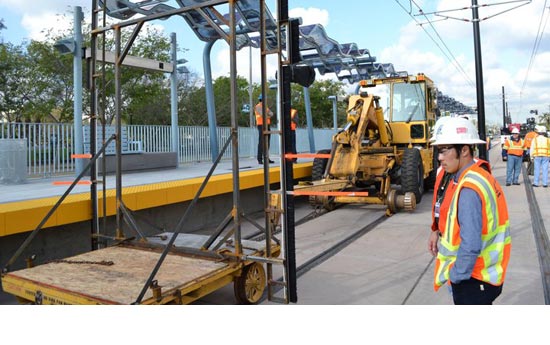
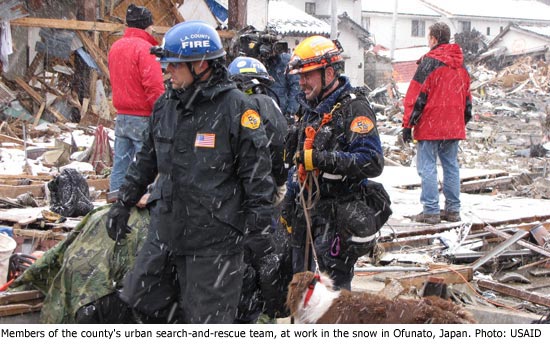
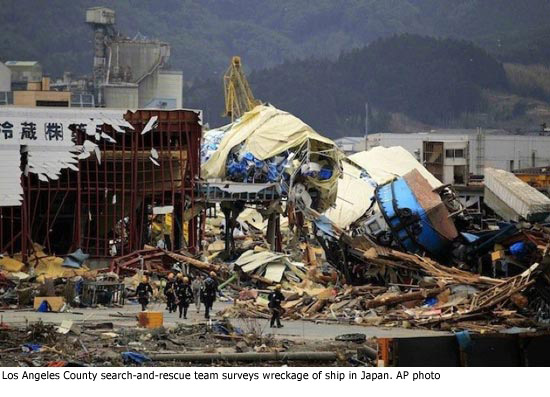
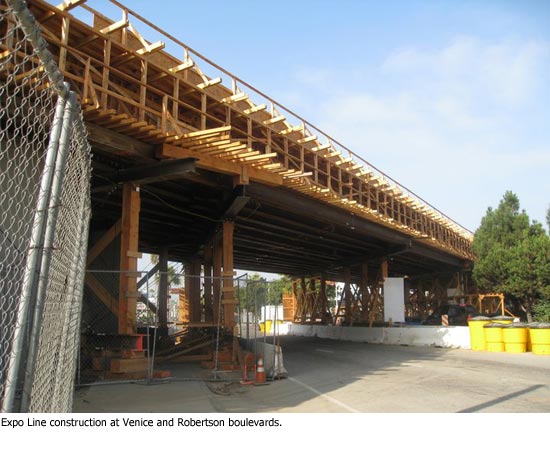
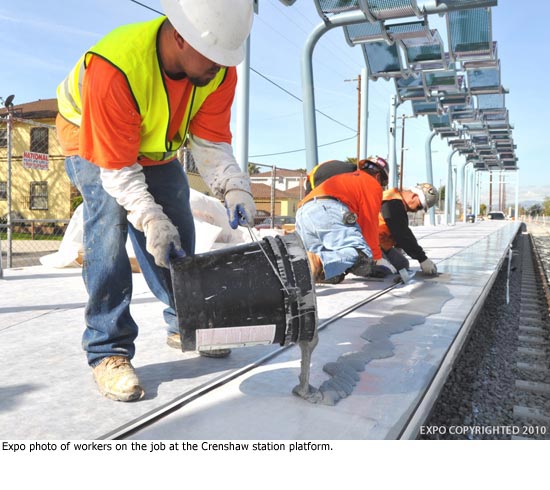
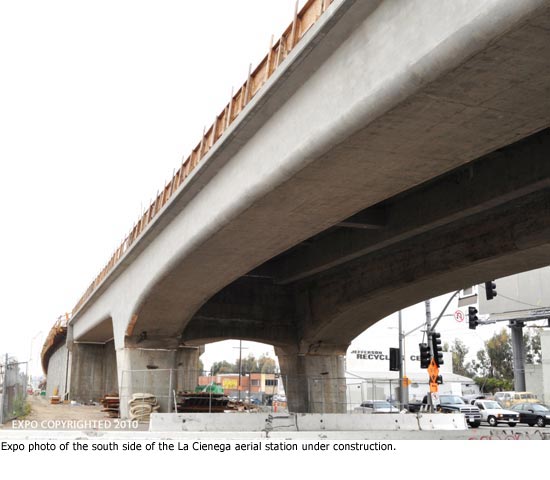
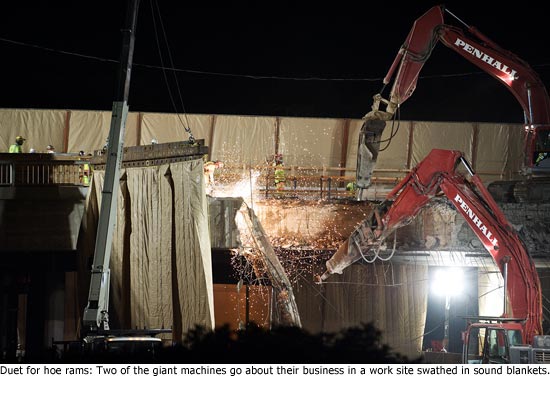
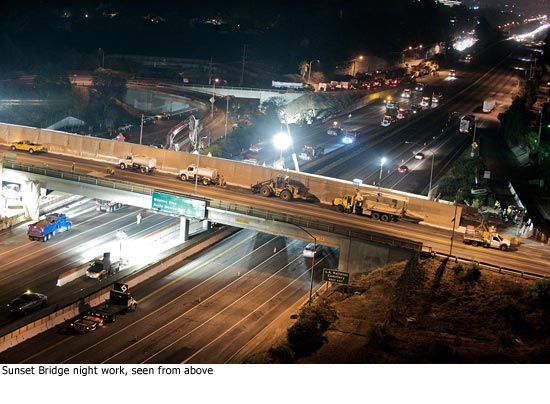
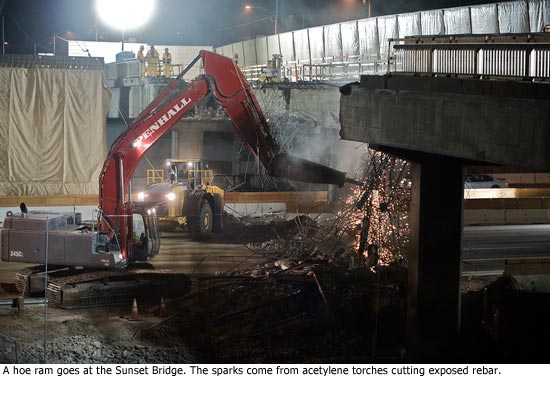
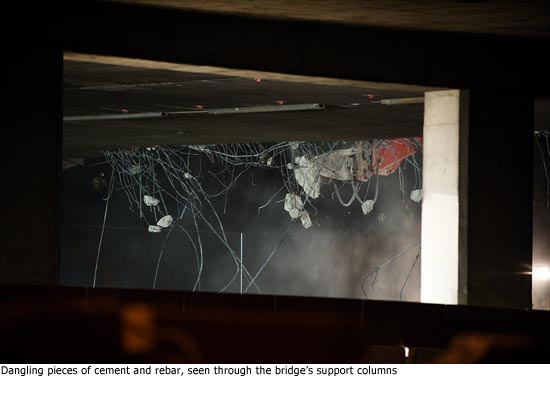
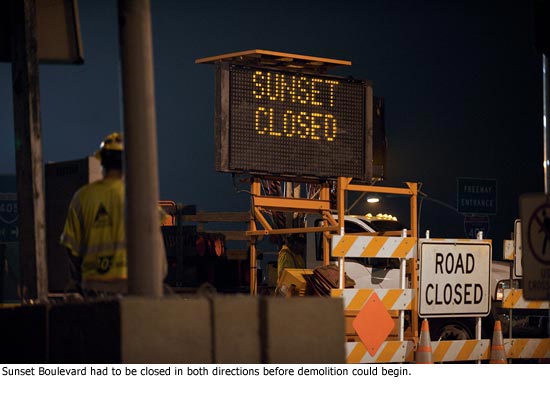







 405 bridge work causes a stink
405 bridge work causes a stink

